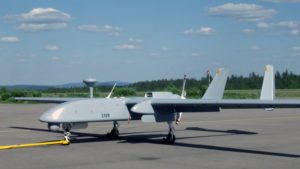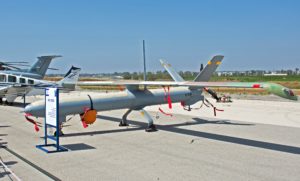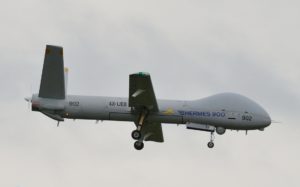
Israel
Precise numbers of Israeli UAVs are extremely hard to come by, as databases and reference publications that are usually most reliable on inventories, such as the Stockholm International Peace Research Institute and the International Institute of Strategic Studies’ Military Balance, contain no solid figures. However, as one of the world’s leading UAV users and manufacturers, and as a country with a very high average operational tempo, it is fair to assume that Israel is one of the largest operators of armed UAVs in the Middle East.
In mid-2017, it was estimated that Israel accounted for more than 60% of international UAV exports over the previous three decades and had delivered 165 UAV units to foreign buyers in that time.[1] All known exports have been supplied unarmed. The vast majority of the Israeli Defense Forces’ (IDF) UAV inventory is also unarmed since their primary function in Israeli doctrine remains the provision of real-time situational awareness for ground forces. However, although it is official Israeli policy to not discuss armed UAV operations, the country does operate at least three types of UAVs which can be armed and have been used to conduct regular strikes against suspected militant targets – the Heron TP, the Hermes 450 and the Hermes 900.
Israel is also a major innovator in anti-drone systems. Its radar-based system, known as the Drone Dome, can identify targets and use a laser to neutralise them from several kilometres away.[2]
In terms of proliferation, more than 50 countries are known to be operating Israeli-made reconnaissance UAVs, although, save for Turkey, none are Middle Eastern and all are unarmed.[3] Israel is not an official member of the MTCR but has unilaterally agreed to abide by its principles and rules (in much the same way that China has). However, Israel’s interpretation of the provisions has not prevented global sales of UAVs which could theoretically be armed and fit the MTCR’s Category 1 or 2 definitions in terms of range. Despite that, integration of non-Israeli munitions would be challenging, and the usable payload of Israeli UAVs is significantly lower than the larger US Predator/Reaper family and China’s Wing Loong and CH-5 offerings.
[1] Elisa Catalano Ewers et al., ‘Drone Proliferation: Policy Choices for the Trump Administration’, Center for a New American Security, June 2017.
[2] Richard Tomkins, ‘Rafael Unveils Drone Dome Anti-Drone System’, United Press International (UPI), 23 June 2018.
[3] Rob O’Gorman and Chris Abbott, ‘Remote Control War: Unmanned Combat Air Vehicles in China, India, Iran, Israel, Russia and Turkey’, Open Briefing, September 2013, p. 11.
Armed UAV inventory

Drone
Heron TP UAV
Type
Medium Altitude, Long Endurance (MALE) UAV
Manufacturer
Israel Aerospace Industries
Number
10-15
Endurance
30+ hours
Loaded Weight
5,670kg
Payload Capacity
2,700kg
Range
1,000km+
Sensor Options
IR and EO cameras; ground moving target indicator (GMTI); synthetic aperture radar (SAR); electronic intelligence (ELINT); electronic warfare (EW) and laser designator
Weaponry
Potentially capable of carrying Rafael Spike anti-tank missiles or other weaponry

Drone
Hermes 450 UAV
Type
Medium Altitude, Long Endurance (MALE) UAV
Manufacturer
Elbit Systems
Number
20-30
Endurance
17–35 hours depending on model and payload fit
Loaded Weight
450kg
Payload Capacity
180kg
Range
300km (limited by line of sight to ground control station)
Sensor Options
IR and EO cameras; GMTI; SAR; ELINT; EW and laser designator
Weaponry
Option for four Rafael Spike anti-tank guided missiles

Drone
Hermes 900 UAV
Type
Medium Altitude, Long Endurance (MALE) UAV
Manufacturer
Elbit Systems
Number
10-15
Endurance
36 hours depending on payload
Loaded Weight
970kg
Payload Capacity
300kg
Range
1,000km+
Sensor Options
IR and EO cameras; GMTI; SAR; ELINT; EW and laser designator
Weaponry
Internal bay and wing hardpoint options, including four Rafael Spike anti-tank guided<br /> missiles
Israel has a strong claim as the global pioneer in the development, integration and use of UAVs of a wide variety of classes into its armed forces.
The country’s pursuit of UAVs on a mass-produced scale dates back to the operational analysis and lessons learned from the Yom Kippur War in 1973 about the urgent need for significantly improved situational awareness for all land formations.[1] Since the mid-1970s, Israel has been a world leader in the development and use of all sorts of UAVs and has aggressively pursued their introduction into service with combat units. The production of UAVs capable of carrying and launching munitions and then recovering to a runway for reuse, such as the Heron TP and Hermes 450, began in the 1990s and is therefore a reasonably recent phenomenon in Israeli UAV developments.
Armed UAVs also seem not to have affected the sort of strike operations that Israel conducts. The country has a policy of never confirming or denying reports of the use of armed UAVs, and Israeli sources in both the industrial and military communities do not discuss the development or use of such weapons. However, there have been many credible reports and even footage over the past decade to support the widespread assumption that in recent years Israel has made regular use of armed Hermes 450 and potentially Hermes 900 UAVs in strikes against suspected militant targets, especially in the Gaza Strip.[2] There are also unconfirmed reports of Israeli drones carrying out strikes against targets in southern Lebanon, Egypt, Syria and even Sudan.[3]
These patterns support the adoption of two distinct operational norms by the Israeli Air Force (IAF) in terms of armed UAV operations. The first is similar to one developed by the United States Air Force (USAF) and RAF in counterinsurgency campaigns using MQ-1 Predator and MQ-9 Reaper UAVs. It consists of employing armed UAVs to conduct interdiction and close air-support strikes as part of their main task of providing long-endurance overwatch and ISR coverage over known trouble spots or active operational areas. In this role, the armed UAV performs much the same tasks as traditional air support using manned ISR platforms and fast jets, except at lower cost and with much greater endurance on station.[4]
A second Israeli operational norm, however, is suggested by reported strikes against high-value personnel and weapons shipment targets in Lebanon, Syria and Sudan as part of deniable strikes where ground forces and/or manned strike aircraft are not involved.[5] This is using the lower political and human risk associated with armed UAVs, compared with manned strike aircraft, to conduct deniable strikes in areas beyond zones of active armed conflict in situations where they otherwise might not be risked. This is more similar to the CIA/USAF targeted assassination programme, which exploited the lower political and operator risk profile offered by armed UAVs to conduct airstrikes against suspected terrorist targets in Pakistan, Yemen, Somalia and elsewhere.[6] Due to the opacity of the Israeli security sector, it is not clear whether this sort of strike, when conducted by Israeli drones, are commanded through the usual IAF structures or fall under intelligence agency direction.
It is important to bear in mind, however, that for the IDF and IAF, the operational possibilities offered by arming UAVs are considered a very useful additional capability to their primary mission, which remains ISR. The Hermes 450 and Hermes 900 can carry ordinance, but their primary role is battlefield surveillance and reconnaissance, and within this role they fit into a large family of UAVs manufactured by Elbit and Israel Aerospace Industries, which range from quadcopters to small ISR UAVs that can be carried in a soldier’s backpack, up to the
Brigade-level Hermes 900. All can be controlled by common ground stations and passed up and down the levels of ground forces and IAF command depending on the tactical situation.
The general feeling in Israel is that if the benefits of UAVs are seen as primarily centred on armed strikes as opposed to ISR and electronic warfare-focused tasks to enable the wider force, this is indicative of a poor national understanding of UAV operations. For dedicated strike UAVs, Israel has a range of loitering munitions for battlefield strike and suppression of enemy air defences, such as the Harby, Harop and Skystrike. However, these do not fit into the bounds of this study as they have more in common with cruise missiles or precision-guided munitions than UAVs.
It is interesting to note that, although the Law of Armed Conflict and international humanitarian law require that military aircraft be marked as such and that their national allegiance be easily identifiable, Israeli UAVs do not typically carry markings or transponders.
The relationship between Israel’s UAV industry and the IDF is extremely close compared to other countries examined in this study (except perhaps Turkey), or indeed competitors globally. Part of the reason for this is the very high proportion of senior personnel in the UAV industry who are either retired or still active duty reserves in the IDF. This helps to ensure that there is a deep commonality of understanding of operational priorities and requirements between UAV developers and the IDF. Israel’s high tempo of operations and perceived threat levels also foster an environment where the IDF regularly adopts UAV technology, which is not fully mature, to test its initial operational utility and then works closely with the defence industry in the field to refine, mature and develop the platform. This ensures that by the time a UAV becomes visible and available for the world to see from Israeli defence industries, it has probably been in active field and potentially combat testing and spiral development with the IDF for many years.[7]
[1] Author interview with senior specialist on IDF technology development, Tel Aviv, 24 July 2018.
[2] See, for example, Mark Garlasco et al., ‘Precisely Wrong: Gaza Civilians Killed by Israeli
Drone-Launched Missiles’, Human Rights Watch, 30 June 2009; Middle East Monitor, ‘Israeli Army Document Confirms Use of Hermes 450 Drones in Assassinations’, 7 April 2016.
[3] See, for example, Jack Khoury, Noa Shpigel and Gili Cohen, ‘Syrians Report Israeli Drone Strike Kills Commander of Pro-Assad Militia’, Ha’aretz, 19 March 2017; Rebecca Tinsley, ‘Why Israel Has Bombed Sudan’, Huffpost, 30 December 2012; Jerusalem Post, ‘Report: Sudan Shoots Down Israeli Drone’, 6 May 2015.
[4] Author interviews with specialists on Israeli UAVs, Tel Aviv, 23–24 July 2018.
[5] For example, see BBC, ‘Sudan Arms Factory Blast: Khartoum to Report Israel to UN’, 25 October 2012, Al Jazeera, ‘Israel Says it Launched 200 Strikes in Syria Since 2017’, 5 September 2018.
[6] On targeted killings and signature strikes, see Dan de Luce and Paul Mcleary, ‘Obama’s Most Dangerous Drone Tactic is Here to Stay’, Foreign Policy, 5 April 2016.
[7] Author interview with senior specialist on IDF technology development, Tel Aviv, 24 July 2018.